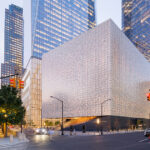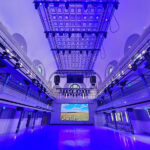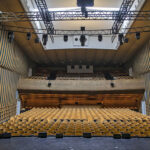With only about 681,000 residents — down from 1.86 million in 1950 — and about $18.5 billion in bills to pay (more than $27,000 per person), the city of Detroit declared bankruptcy in mid-2013. It was, by far, the largest municipal default in U.S. history. The city’s financial conundrum is a puzzle that might even stump sculptor Auguste Rodin’s iconic Thinker, a casting of which is perched high on a pedestal outside the Detroit Institute of Arts (DIA) museum — and one of more than 60,000 artworks in the city-owned museum, now drawing more than just aesthetic interest from the city’s beleaguered creditors.
 After an additional $150 million in legal fees, a federal judge was preparing in early November to approve an exit plan that would ease the city’s debt burden by some $7 billion. (So far, legalities and binding private agreements have thwarted any schemes to cash in on the museum’s art.)
After an additional $150 million in legal fees, a federal judge was preparing in early November to approve an exit plan that would ease the city’s debt burden by some $7 billion. (So far, legalities and binding private agreements have thwarted any schemes to cash in on the museum’s art.)
But another kind of artistry may serve as a gleam of hope. Despite the exodus of more than a million city residents, the greater Detroit metro area (including neighboring Windsor, Ontario) is still 5.7 million strong. And Detroit’s downtown arts scene is drawing more people back to the city’s Midtown core.
 Dlectricity Rising
Dlectricity Rising
A case in point is Dlectricity, a downtown festival centering on son et lumière light art installations that launched in 2012 and expanded in 2014. Inspired by Nuit Blanche festivals that have been staged for years in Paris, Rome, Toronto and New York, the 2012 event was deemed a success with total attendance near 75,000. The 2014 event doubled that, bringing an estimated 150,000 to the city’s downtown from 7 p.m. to midnight Friday, Sept. 26 and Saturday, Sept. 27, 2014.
Part of the reason for the 2014 event’s bigger draw was an expansion in the total luminous firepower. A total of 39 works from 35 light artists were presented, with large-format projections and lighting transforming a mile-long stretch of Woodward Avenue between the DIA and the Max M. Fisher Music Center.
The festivities included displays of visual artistry, performances, food truck cuisine and a bicycle parade, among other attractions. But one of the primary focal points was a work called P.O.V., which transformed the facades of both the DIA’s entrance and another city landmark, the Detroit Public Library (DPL), across the street in a narrative interplay of visuals and sound.
P.O.V. was presented by DTE Energy and produced by Mindfield, a Detroit-based provider of interactive media, animation and film and video design services. Mindfield turned to XL Video and TLS Productions, Inc. for the large-format projection, lighting and audio gear that would bring their repeating 6 minute, 45 second long son et lumière to life.
 Projection and Video
Projection and Video
XL Video’s team overcame a number of challenges implementing P.O.V.’s large-format building façade projections, not the least of which were constraints in terms of both setup time and overall budget.
Logistically, the DIA and DPL buildings are located on both sides of a busy four-lane street, and the project required wireless, synchronized projection mapping on both buildings that originated from a single video control space. Setup time was also limited in the all-outdoors environment, where equipment and staff were exposed to the weather.
The projection surface area of the city’s public library measured approximately 120 by 70 feet (WxH), and the façade includes seven arched and recessed balconies that presented the XL team with real challenges for alignment and dealing with shadows.
The DIA museum’s projection surface measures 80 by 60 feet (WxH). There, Rodin’s Thinker sculpture, positioned high on its stone pedestal, sat directly in the projection path and could not be moved. After some pondering on the part of the XL team, they devised a creative work-around in terms of projection positioning.
“Our client, Mindfield, provided 3D laser scans of the actual buildings, and so we were able to create 3D projection simulations in the Cinema4D software,” says German Perl, XL Video’s U.S. media manager. “This allowed us to simulate the light distribution and to choose the best solutions for projection distances, lens focal lengths and light output.”
XL opted for Barco HDX-W20 Flex projectors, using their built-in warp engines for stack and lens corrections. The playback and final mapping was made with Dataton Watchout software on the XL Video media servers. The playback units were located across Woodward Avenue and were synchronized with a wireless network bridge.
The Watchout software also provided synchronous audio playback and the corresponding time code for audio and lighting provided by TLS Productions.
“As with all successful projects, close collaboration with the stakeholders was key,” says Leslie Dillingham, XL Video’s senior account executive. “Working closely with the professionals at Mindfield and TLS made the challenges of this project much easier to manage.”
The Lighting Complement
Ann Arbor, MI-based lighting and audio rental company TLS Productions, Inc. providing the lighting and audio gear to complement XL Video’s large-format building façade projections for Mindfield’s son et lumière, and TLS LD and production manager Robert Glowacki called TLS’ early meetings with project partners as “a huge jump-start” in ensuring the project’s success.
TLS’ role, Glowacki notes, was to provide all the lighting and audio support needed to complement XL Video’s façade projections.
“Originally, the plan was to match lighting color palettes to video color schemes, but the decision was made to instead have various artists work and create their own concepts and subsequent art for each installation, thus leading to better end results with more creative depth,” he notes.
“The design process, started early, with a long list of video shots to build from,” Glowacki continues. “These shots started a myriad of thoughts about lighting and sound design.” Over a span of several weeks leading up to the big two-night event, Glowacki and others at TLS were able to conduct site surveys and discuss different options for enhancing the projections to fully engage the crowds expected at the DIA and DPL entrances — key focal points for the Dlectricity event as a whole.
“The first concern was to make sure the lighting did not take away and become the star of the show,” Glowacki notes. Instead, “it was created and utilized to enhance the project. The second concern was, ‘How do you use two of the most beautiful structures in Detroit…to your advantage?’ So right away my thoughts, being a Detroit native and resident, was to show people that there is beauty in Detroit, and that too often national media reports only on the bad news that exists in the city, not the good things. Detroit is a growing and thriving community, and a home for art and artists. That is what a lot of the P.O.V. content speaks to.”
Preparation, On and Off Site
Once video media, concepts, and thoughts started to flow in, TLS Productions used its new facility in Ann Arbor for pre-programming and pre-production, with an off-white cyclorama curtain used to build lighting cues. “The intention during pre-production was to build an overall stack of looks and movements, and then, once on site, make adjustments to the overall appearance, thus creating a cohesive and smooth flowing final show,” Glowacki notes.
Finally, it was time to begin work onsite. “As this began, conversations were had with the DIA director and curators on many topics, with the specific goal in mind of not compromising any of the art that existed out in front of the DIA,” Glowacki says. “This became something that was always on the minds of those involved with the P.O.V installation.”
After a long day of load-in onsite, all crews were up and running and ready for nightfall. As the sun set the evening before Day One of the event, Glowacki began stepping through each look and movement, altering the various looks and movements in accordance with the architecture, making color changes to better match video, and fine-tuning the timing of all elements. The show was run via SMPTE timecode, engineered and provided by XL Video.
TLS’ crew, worked long into the night on Thursday, Sept. 25, the last night before the event took place, alongside the crew from XL Video. “That was an interesting experience all by itself, to be the only ones on the streets of Detroit, knowing that the next day the collaborative efforts of all were to be viewed by a huge crowd of attendees,” Glowacki recalled. “Some of the challenges were making sure to not bleed too much into the projection, instead making it look like one interrelated image. And the fact that the view of the buildings were blocked by trees, power lines, and other items, led to a lot of walking around to make sure all working elements were behaving properly.”
“It was a great collaboration overall,” Glowacki adds, noting the “great discussions” between the production team and the individual creators of the artwork, “throwing ideas back and forth” as the second — and not likely the last — Dlectricity took place. For Glowacki, the “absolutely amazing experience” was made even more gratifying knowing that the crew’s efforts were taken on behalf of a project that celebrated “the artistry and resiliency that exists within the City of Detroit.”
Credits
Lighting Co: TLS Productions, Inc.
Lighting Designer and Production Lead: Robert Glowacki
Executive Producer: Brad Hayes
Lighting and Audio Tech: Brian Walker
Marketing/New Business: Carl Kedzierski
Video Co: XL Video
Video Producer: Leslie Dillingham
Video Warping/Playback: German Perl
Projectionist: Billy Dobbs
Project Manager: Ryan Hooper
Video Content: Mindfield
Creative Director: Mike Dryden
Motion Graphics/3D Designers: Billy Chitkin, Lucas Flora
Editor/Post Production Director: Sean Emery
Executive Producer: David Carleton
Production Manager: Sarah Babila
Video Director: Tom Carleton — Video Director
Window Prep/Papering: Andriy Pereklita, Jason Baker, Gene Diamond
Misc. Credits: Talent: Mason Heidger, Ashlee McLemore; “Warriors” and “Oktober” music licensed by Andy Favre; Strt Trbl music composer/producer: Jacob Cardec.
Other P.O.V. Supporters: Annemarie Borucki, Alivia Zivich, Jon Hudson, the Dlectricity Board, Midtown Development, The Detroit Institute of Arts, The Detroit Public Library and Troy Design & Manufacturing.
Gear
Lighting and Audio (from TLS Productions):
2 grandMA Light consoles
2 grandMA Command Wings w/PC
6 City Theatrical SHoW Baby wireless DMX units
12 Martin MAC III Profiles
24 Martin MAC 301 FCs
20 Elation RGB Impression 90s
3 Leprecon 208V 30x power distros
8 QSC KW152 powered speakers
4 QSC KW181 powered subs
1 LS9 32 Yamaha mixer
1 Yamaha MG10XU analog mixer
1 XLR Package
1 Feeder Package
1 DMX Package
1 Power Cable Package
Video (From XL Video)
4 Barco HDX-W20 projectors
1 Dataton Watchout system with media servers
1 Wireless network bridge
The projection setup included two stacks of two HDX-W20 projectors, one for each building’s facade. XL Video also made use of Cinema4D software for projection simulations.


